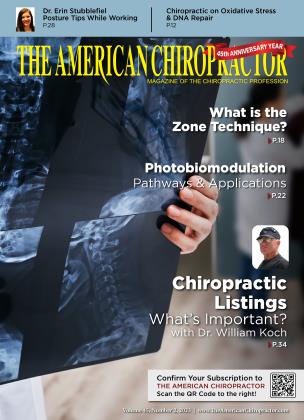After 40 years in private practice and being involved in state, national, and international politics for nearly the same number of years, I believe I have gained an accurate perspective about the public’s image of chiropractic. At best, the public’s image of chiropractic is that we can help low back pain. Beyond the first few months in practice, when my mind was on survival, I have spent my career contemplating and taking action on what it will take for the world to accept the great chiropractic principle — the body heals itself, is a self-organizing, self-generating organism, and a spine free of nerve interference accomplishes that better than a spine with nerve interference. Doctors of chiropractic are the best well-trained healthcare providers to help the body self-heal and achieve a state of wellness. As you read the definition of wellness below, you will notice it states, “as an actively pursued goal.” First, this implies that a person is involved in their health care, including spinal care beyond pain relief.
As an actively pursued goal, I have realized that I must personally make other proper lifestyle choices daily in addition to regular chiropractic adjustments. It is the doctor of chiropractic’s responsibility to share this information with not only their patients but also their community.
wellness /'wel-nes/ noun
The state of being in good health, especially as an actively pursued goal. “Measures of a patient’s progress toward wellness.”
My intention in writing this article is twofold. First, I want to offer a model of practice that will educate patients about wellness and increase patient retention and referrals at the same time: Secondly, I’d like to introduce a program to obtain an abundance of new patients while sharing wellness principles outside your office. So here we go!
My time is best spent in the office, refining my skills and becoming the best adjuster I can be because the adjustment has the most profound effect on human physiology, more than any other single thing I can do. With that said, I also eat right, think right, and move right. I also ensure I get adequate sleep besides getting regular chiropractic care. I am aware of my ergonomics while at a desk, lifting, standing for prolonged periods, etc. I believe if it’s good for me, it’s good for my patients, and it is my responsibility to teach these proper lifestyle choices.
On the other hand, when I’m adjusting, I do not want to answer a question about a pillow, vitamin, or anything else that takes my time away from my primary purpose — giving the best adjustment possible. To this end, I highly recommend that the doctor lectures in his office, or you can have a staff member lecture as well. I have such an abundance of information to share that I have two in-office workshops — the Basic and Advanced Better Results Workshop(s).
Besides sharing information to help people get the best results with their health, my other goal is to increase retention and increase referrals. This only happens when a patient understands the chiropractic principle of keeping their spine free of nerve interference. Therefore, every lecture in or out of the office needs to have a powerful closing, with you telling your story or somebody else’s. Having a patient(s) at your lectures to give a testimonial is also ideal. Considering the length requirement of this article, other keys for giving an effective presentation will appear in a subsequent article. For now, “the chiropractic close” needs to cover three concepts, which do not necessarily have to be done just at the end.
1 How the body is a self healing, self organizing entity, how the nervous system regulates every cell tissue and function of the body!
2 How subluxation causes nerve interference and how a spine free of subluxation helps the body to stay healthy. Be specific mentioning how the nervous system free of nerve interference helps digestion 1, immunity2, cardiovascular system3, hormonal control4, etc.
3 The doctor of chiropractic is by far the most well trained health care provider to remove nerve interference and correct the subluxation.
When lecturing out of your office, it is essential to cover these three concepts. If you are doing a lecture on nutrition, athletic performance, or any other health topic, plan your timing correctly to fit your topic around these three concepts.
When we meet again in a subsequent article, I will give you the most effective way to book out-ofoffice wellness workshops in local industries, schools, and houses of worship, and you will be the wellness expert in your community.
Stephen Simonetti, DC valedictorian from Life Chiropractic College in 1983, and has been in private practice for 40 years in Whitestone, New York. He has served as President of the Congress of Chiropractic State Associations (2004-2006), President of the New York Chiropractic Council (2004-2006), DPI/NGO United Nations Chiropractic Representative (20122017), Member of the Fellows of the International Chiropractors Association, as well as a United States Representative to the Identity Consultation Task Force (2005). Dr. Simonetti is President of the Wellness for All Foundation, which is a nonprofit organization whose purpose is to educate and improve the social development of orphans and other underprivileged children (2015-current). He can be contacted at917 494-9383 or [email protected].
References
1. Indigestion and heartburn: a descriptive study of prevalence in persons seeking care from chiropractors. Bryner P and Stcierker. PG. Journal of Manipulative and Physiological Therapeutics 1996: 19(5): 317-23.
2. The Effects of Specific Upper Cervical Adjustments On The CD4 Counts of HIV Positive Patients ' “ (Chiropractic Research Journal 1994:3(1): 32-39.
3. University of Chicago Medical Center “Special Chiropractic Adjustment Lowers Blood Pressure. ’’ScienceDaily. ScienceDaily, 16 March 2007.
4. Plaza-Manzano, G., et al. Changes in biochemical markers of pain perception and stress response after spinal manipulation. Journal Orthopaedic and Sports Physical Therapy 2014:44(4):231-9. doi: 10.2519/jospt. 2014.4996.
 View Full Issue
View Full Issue






